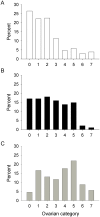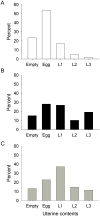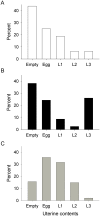Where, when and why do tsetse contact humans? Answers from studies in a national park of Zimbabwe - PubMed (original) (raw)
Where, when and why do tsetse contact humans? Answers from studies in a national park of Zimbabwe
Stephen J Torr et al. PLoS Negl Trop Dis. 2012.
Abstract
Background: Sleeping sickness, also called human African trypanosomiasis, is transmitted by the tsetse, a blood-sucking fly confined to sub-Saharan Africa. The form of the disease in West and Central Africa is carried mainly by species of tsetse that inhabit riverine woodland and feed avidly on humans. In contrast, the vectors for the East and Southern African form of the disease are usually savannah species that feed mostly on wild and domestic animals and bite humans infrequently, mainly because the odours produced by humans can be repellent. Hence, it takes a long time to catch many savannah tsetse from people, which in turn means that studies of the nature of contact between savannah tsetse and humans, and the ways of minimizing it, have been largely neglected.
Methodology/principal findings: The savannah tsetse, Glossina morsitans morsitans and G. pallidipes, were caught from men in the Mana Pools National park of Zimbabwe. Mostly the catch consisted of young G. m. morsitans, with little food reserve. Catches were increased by 4-8 times if the men were walking, not stationary, and increased about ten times more if they rode on a truck at 10 km/h. Catches were unaffected if the men used deodorant or were baited with artificial ox odour, but declined by about 95% if the men were with an ox. Surprisingly, men pursuing their normal daily activities were bitten about as much when in or near buildings as when in woodland. Catches from oxen and a standard ox-like trap were poor indices of the number and physiological state of tsetse attacking men.
Conclusion/significance: The search for new strategies to minimize the contact between humans and savannah tsetse should focus on that occurring in buildings and vehicles. There is a need to design a man-like trap to help to provide an index of sleeping sickness risk.
Conflict of interest statement
The authors have declared that no competing interests exist.
Figures
Figure 1. Wing fray classes of male G. m. morsitans caught from men and ox.
Percent distribution of wing fray classes of male G. m. morsitans caught from men (N = 211) and ox (N = 100).
Figure 2. Ovarian categories of female G. m. morsitans from (A) men, (B) ox and (C) traps.
Percent distribution of ovarian categories of female G. m. morsitans from (A) men, (B) ox and (C) traps. Sample sizes of 257, 94 and 283 for men, ox and traps, respectively.
Figure 3. Uterine contents of female G. m. morsitans from (A) men, (B) ox and (C) traps.
Percent distribution of uterine contents of female G. m. morsitans in ovarian categories>0, from (A) men, (B) ox and (C) traps. Sample sizes of 189, 78 and 270 for men, ox and traps, respectively.
Figure 4. Uterine contents of female G. pallidipes from (A) men, (B) ox and (C) traps.
Percent distribution of uterine contents of female G. pallidipes in ovarian categories>0, from (A) men, (B) ox and (C) traps. Sample sizes of 16, 115 and 1498 for men, ox and traps, respectively.
Similar articles
- A neglected aspect of the epidemiology of sleeping sickness: the propensity of the tsetse fly vector to enter houses.
Vale GA, Chamisa A, Mangwiro C, Torr SJ. Vale GA, et al. PLoS Negl Trop Dis. 2013;7(2):e2086. doi: 10.1371/journal.pntd.0002086. Epub 2013 Feb 28. PLoS Negl Trop Dis. 2013. PMID: 23469309 Free PMC article. - Towards an early warning system for Rhodesian sleeping sickness in savannah areas: man-like traps for tsetse flies.
Vale GA, Hall DR, Chamisa A, Torr SJ. Vale GA, et al. PLoS Negl Trop Dis. 2012;6(12):e1978. doi: 10.1371/journal.pntd.0001978. Epub 2012 Dec 27. PLoS Negl Trop Dis. 2012. PMID: 23301107 Free PMC article. - Optimising targets for tsetse control: Taking a fly's-eye-view to improve the colour of synthetic fabrics.
Santer RD, Vale GA, Tsikire D, Torr SJ. Santer RD, et al. PLoS Negl Trop Dis. 2019 Dec 12;13(12):e0007905. doi: 10.1371/journal.pntd.0007905. eCollection 2019 Dec. PLoS Negl Trop Dis. 2019. PMID: 31830039 Free PMC article. - Monitoring trypanosomiasis in space and time.
Rogers DJ, Williams BG. Rogers DJ, et al. Parasitology. 1993;106 Suppl:S77-92. doi: 10.1017/s0031182000086133. Parasitology. 1993. PMID: 8488074 Review. - Perspectives on Odor-Based Control of Tsetse Flies in Africa.
Mireji PO, Mang'era CM, Bwana BK, Hassanali A. Mireji PO, et al. Front Physiol. 2022 Feb 18;13:831618. doi: 10.3389/fphys.2022.831618. eCollection 2022. Front Physiol. 2022. PMID: 35250633 Free PMC article. Review.
Cited by
- Tsetse flies (Glossina morsitans morsitans) choose birthing sites guided by substrate cues with no evidence for a role of pheromones.
Adden AK, Haines LR, Acosta-Serrano Á, Prieto-Godino LL. Adden AK, et al. Proc Biol Sci. 2023 Apr 26;290(1997):20230030. doi: 10.1098/rspb.2023.0030. Epub 2023 Apr 26. Proc Biol Sci. 2023. PMID: 37122250 Free PMC article. - Epidemiology of human African trypanosomiasis.
Franco JR, Simarro PP, Diarra A, Jannin JG. Franco JR, et al. Clin Epidemiol. 2014 Aug 6;6:257-75. doi: 10.2147/CLEP.S39728. eCollection 2014. Clin Epidemiol. 2014. PMID: 25125985 Free PMC article. Review. - A neglected aspect of the epidemiology of sleeping sickness: the propensity of the tsetse fly vector to enter houses.
Vale GA, Chamisa A, Mangwiro C, Torr SJ. Vale GA, et al. PLoS Negl Trop Dis. 2013;7(2):e2086. doi: 10.1371/journal.pntd.0002086. Epub 2013 Feb 28. PLoS Negl Trop Dis. 2013. PMID: 23469309 Free PMC article. - Tackling Sleeping Sickness: Current and Promising Therapeutics and Treatment Strategies.
Jamabo M, Mahlalela M, Edkins AL, Boshoff A. Jamabo M, et al. Int J Mol Sci. 2023 Aug 7;24(15):12529. doi: 10.3390/ijms241512529. Int J Mol Sci. 2023. PMID: 37569903 Free PMC article. Review. - Towards an early warning system for Rhodesian sleeping sickness in savannah areas: man-like traps for tsetse flies.
Vale GA, Hall DR, Chamisa A, Torr SJ. Vale GA, et al. PLoS Negl Trop Dis. 2012;6(12):e1978. doi: 10.1371/journal.pntd.0001978. Epub 2012 Dec 27. PLoS Negl Trop Dis. 2012. PMID: 23301107 Free PMC article.
References
- Maudlin I (2006) African trypanosomiasis. Ann Trop Med Parasitol 100: 679–701. - PubMed
- Kaare MT, Piccozi K, Mlengeya T, Fevre EM, Mellau MS, et al. (2007) Sleeping sickness - a re-emerging disease in the Serengeti? Travel Med Infect Dis 5: 117–124. - PubMed
- Simarro PP, Franco JR, Cecchi G, Paone M, Diarra A, et al. (2012) Human African Trypanosomiasis in Non-Endemic Countries (2000–2010). J Travel Med 19: 44–53. - PubMed
Publication types
MeSH terms
LinkOut - more resources
Full Text Sources
Medical



